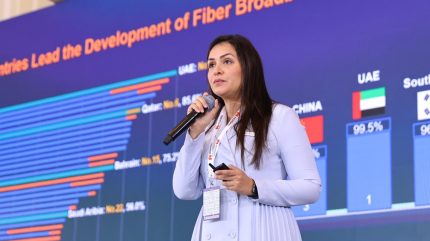
Expected growth in high-speed broadband services is projected to continue, driven by both consumer needs and government initiatives aimed at expanding fibre infrastructure. With efforts by local governments, telecom regulators, and operators to improve coverage ongoing, fibre will remain the leading and fastest-growing fixed broadband technology.
As the expansion of fibre broadband gains momentum, Passive Optical LAN (POL) networks are quickly becoming the preferred choice for enterprise and modern campus networks. Characterised by its use of fibre optic cables, POL – unlike traditional copper Ethernet LANs – adopts a simplified two-layer network architecture, greatly reducing the number of active network devices and contributing to overall energy savings. POL technology also supports high-speed data transmission, ensuring that as data demands grow, the fibre infrastructure can remain unchanged, and the network can be upgraded more easily. Additionally, robust encryption measures integrated into POL solutions help ensure the security of network transmission.
Meanwhile, on the home front, there is a pressing need to enhance entry package speeds of fibre broadband and fully unlock its potential for households. Utilising Fibre to the Room (FTTR) technology – an advanced technology that extends fibre optic internet connectivity directly to individual rooms within a home or building – can provide ultra-fast, stable, and reliable internet access, while eliminating common issues such as Wi-Fi dead zones. FTTR also allows gigabit speeds necessary for bandwidth-intensive activities like 4K streaming, gaming, and operating smart home devices.
FTTR’s thin, transparent fibre cables replace traditional network wiring for seamless integration into existing home layouts and are designed to be aesthetically unobtrusive. The technology also supports advanced Wi-Fi standards, such as Wi-Fi 7, implements smart roaming technology ensuring quick handover times (less than 10ms) for uninterrupted connectivity across devices, and accommodates heavy internet usage by multiple devices simultaneously. This evolution not only promises faster internet speeds but also enhances the overall digital experience for users, making homes truly future-proof.
Fibre broadband development
In May, at Huawei’s Global Optical Summit (GOS) Middle East and Central Asia, Tashkent, Uzbekistan, Ms. Kholoud Aldorgham, Director General of Fiber Connect Council MENA, told delegates that to unlock the full potential of broadband, we need to accelerate the expansion of Passive Optical LAN (POL) and Fibre to the Room (FTTR) networks.
“From networks offering hundreds of Kbps to today’s more fibre-based broadband with up to 10Gbps speed,” Aldorgham said, “the evolution to higher video quality standards and more bandwidth-hungry applications, plus the shift of intelligence to the cloud, means demand on broadband networks is only set to accelerate further.”
Aldorgham showed how 70% of global network traffic is already accessed through fixed broadband networks, and that by 2028, it is expected that global fixed broadband traffic will increase by another 50%, reaching 8.7 zettabytes. “Therefore, fibre broadband network is becoming an important new infrastructure to support the development of the national digital economy,” she noted.

The gigabit city
“Across the MENA region, we are witnessing remarkable progress,” Aldorgham continued. “One shining example is the United Arab Emirates, which now leads the world in Fibre-to-the-Home (FTTH) with an extraordinary 99.5% penetration rate. This is a reflection of national vision, policy alignment, and investment in digital infrastructure that places people and innovation at the centre of development.”
However, the development of fibre optic broadband in the Middle East and Central Asia region also faces significant regional imbalances, warned Aldorgham. Only six Gulf Cooperation Council (GCC) countries have fibre optic broadband penetration rates exceeding 40%, while in the Central Asian region, there are still many households covered by copper wires or no fixed broadband coverage at all. Take-up rate of fibre optic broadband in Uzbekistan (host to the conference) is close to 80%, which demonstrates the residents’ desire and demand for Fibre optic broadband, she noted.
“Fibre is central to the realisation of smart and Gigabit Cities,” Aldorgham said. “Cities that are built on ultra-high-speed connectivity, enabling everything from real-time services and autonomous transport to e-health, smart energy, and digital education. We call on governments and regulatory authorities of all countries to attach great importance to the network construction of fibre broadband and introduce policies and subsidies to provide support.”
Fifth Generation Fixed Network Advanced (F5G-A)
Stepping up to meet this challenge, Huawei announced its Fifth Generation Fixed Network Advanced (F5G-A) series solutions at the Summit. The new F5G-A portfolio sees a comprehensive approach to optical infrastructure and addresses the full spectrum of fast fibre needs, from smart campuses demanding seamless connectivity to perimeter security systems requiring precision monitoring capabilities. Importantly, F5G-A technologies are perfect for enabling businesses to unlock the full potential of emerging technologies such as AI, Internet of Things (IoT), and cloud computing.
Charles Shen, Vice President of Huawei Middle East and Central Asia ICT Marketing and Solution Sales, noted that Huawei has already worked with partners in the Middle East and Central Asia to deploy optical tech in data centres, industries, and campuses. According to Shen: “Moving forward, we’ll combine Optical and AI for smarter, tailored solutions. Let’s shape the intelligent future together.”

